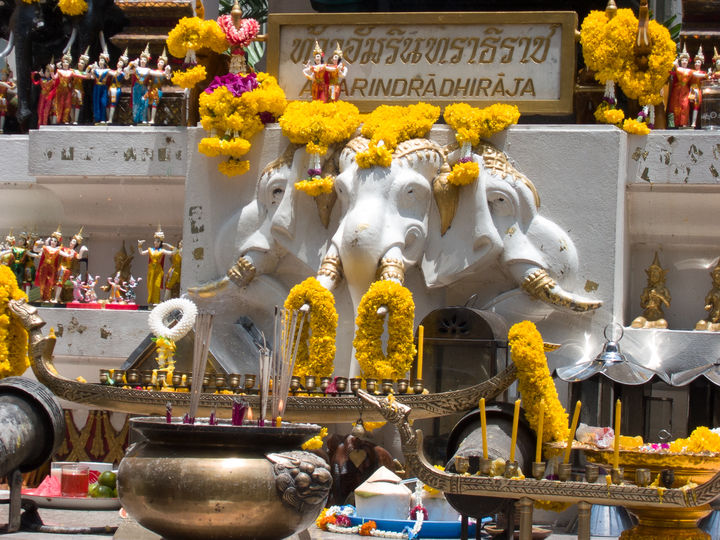Shrines
Bangkok, Thailand
About 95% of Thais are officially Theravada Buddhists, although that 95% probably covers everything from sages and zealots to people who think of themselves as Buddhists but haven't seen the inside of a wat in decades. Apart from the ubiquitous monks in their 'saffron' robes (which actually span a spectrum that runs from brownish-yellow to lifejacket orange), the visible symbols of Buddhism are the wats, temple compounds where groups of monks are assembled together. But there's also what – to my eye at least – looks like a minor parallel religion, represented by the spirit houses and shrines.
A spirit house is a kind of dollshouse-sized temple set on a plinth. Many Thai buildings seem to have one. Its purpose is to give the spirits a place to live, so that they don't have to share the main house with its human occupants (which always leads to trouble). The spirits are household familiars, like Thai lares and penates, and they receive regular offerings of food, flowers and incense to encourage them to stay outside in the spirit house and not come and make trouble indoors. The size of the spirit house is supposedly proportional to the size of the human house, so an apartment building will have a larger spirit house than a single-family dwelling, while a multi-storey hotel may have a spirit house the size of a small bungalow.
Or it may have a shrine, and here's the oddity. The shrines sometimes feature Buddhist themes – there's a fine large Buddha sheltering under a multi-headed naga on Thanon Ratchadamri – but more often than not they seem to be Brahman, with statues of Hindu deities such as Indra or Ganesh. To me, this seems incongruous, rather as if Muslim countries were dotted with little wayside synagogues where the faithful could stop off and pay their respects to Abraham and Moses. But Asian religion is nothing if not syncretic, so perhaps there's nothing strange about it.
The most interesting of the shrines we've seen so far has been the Erawan Shrine, built to bring good fortune to the neighboring Grand Hyatt Erawan hotel. The four-faced Brahma figure at the center of the shrine is of relatively modest dimensions, while the shrine itself occupies a small lot adjoining busy Thanon Ploenchit that is probably about forty feet by forty. What it lacks in size, it makes up for in intensity.
At night, the central shrine is surrounded by a constant crowd of worshippers, laying jasmine garlands before the statue of Brahma, washing their hands in water from several large brass ewers set out around the shrine, lighting bundles of incense sticks. A pith-helmeted attendant acts as a kind of intercessionary, moving particular garlands closer to the statue and ensuring that the oil lamps for lighting incense remain lit. A concession stand sells whatever the worshippers need, from incense and garlands to elephant statues. A large collection of elephant statues of all sizes - and four stray zebras - stands to one side. The two largest elephants are of polished reddish wood, and have been liberally decorated with small squares of gold leaf. A pair of matching cement elephants stand by the perimeter fence, inscriptions on their bases revealing them to be a gift from a Vietnamese couple living in Canada.
The truly devout, or those who have a special prayer that they want answered, can command a performance by a small group of traditional dancers clad in long silver-scaled surcoats and pointed hats. The number of dancers performing and the duration of the dance depends on the size of the offering: rates are marked by the concession stand. A modest donation might get a brief performance by a couple of dancers; a more handsome offering might bring the whole group out on stage to perform. During the dance — a graceful, slow-moving affair accompanied by languid hand-gestures and muted chanting — the donor kneels at the side of the stage, hands clasped in prayer.
I don't know if the spirits that would otherwise haunt the Grand Hyatt resent the fact that their spirit house has been replaced by a shrine that draws such a cosmopolitan crowd - Indian deities, South Asian visitors, Thai locals, and a scattering of farangs with cameras - but reportedly the shrine has brought luck to the Grand Hyatt. Maybe, like us, the spirits just like to sit around the shrine and watch the goings on, fascinated by the constant bustle and the hum of worship going on about the altar.
